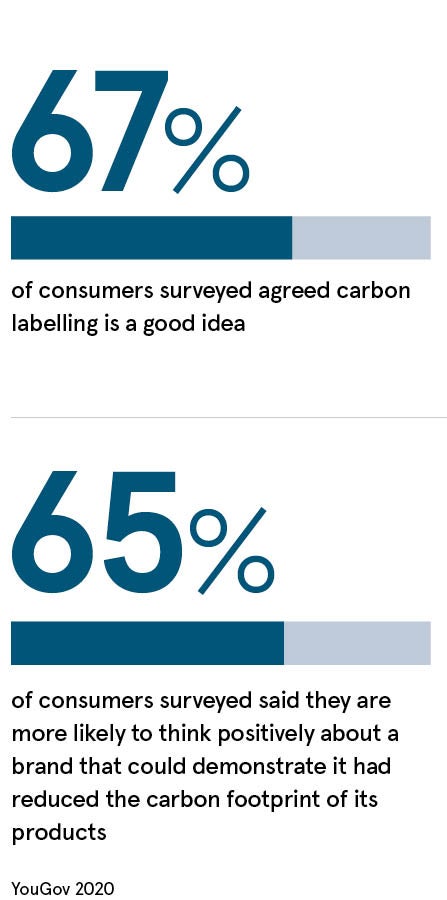
Corporate net zero targets are announced weekly and the rhetoric around net zero has reached fever pitch. However, the challenge is now turning these words into actions. Many businesses are only just starting to look at their operations more closely and decarbonise, while others are realising that it’s going to require real tenacity to achieve their targets.
There’s also a new reality setting in for most organisations. The majority of their emissions are actually along their value chain - upstream supply chain and downstream products in use – tackling these so-called Scope 3 emissions will, for many, be a massive issue.
In fact, supply chain greenhouse gas emissions can be 11 times as high as operational emissions, according to non-profit the CDP. Reducing emissions therefore doesn’t stop at the head office - operational emissions are just the tip of the iceberg.

“Many companies want to do the right thing but the control they have on their overall emissions can be limited. It’s a really big and tricky problem but doing nothing is not an option,” explains Hugh Jones, managing director, advisory at the Carbon Trust, a global, mission-led organisation that works with governments, investors, businesses and organisations to accelerate the delivery of a sustainable, low carbon economy.
“Corporations are going to have to innovate and make significant changes to their business model in order to drive progress. They will have to account for emissions across their full value chain. Only through collaboration can businesses tackle this challenge.”
Many organisations are engaging with their direct and multi-tier suppliers in order to source products with lower emissions. Others are looking at alternative production models, involving remanufacturing, reuse and recycling of materials and parts to create new products. This is a move to a more circular economy, reducing the need for raw materials.
“We’ve seen a lot of this in the fashion industry with fibres for clothing and in ICT with components and equipment,” adds Jones. “There are also an increasing number of industry-wide initiatives that are driving change in supply chains, while some big corporate buyers are now asking their suppliers to decarbonise as part of their purchasing criteria. For example, certain supermarkets require their suppliers to comply with a range of environmental criteria including tackling carbon emissions.
“Others are setting up innovation centres and designating staff specifically to focus on this issue. The dial is shifting. Just look at the new job titles that are cropping up, such as ‘sustainable supply chain manager’ or ‘director of supply chain innovation’. It’s a sign that this is being taken seriously and is becoming part of the mainstream agenda.”
The fight against climate change will be won by those businesses that do things differently. Setting targets will not be enough. By measuring their organisational and value chain carbon footprints - and where appropriate the footprint of a product’s full lifecycle - businesses can identify areas for innovation that will reduce emissions and also potentially save money.
“Some organisations are able to cut costs while they reduce emissions by taking a more carbon-centric approach. Knowing where your emission hotspots are can help focus efforts and often prompt fundamental shifts in business models,” says Jones.
The Carbon Trust has two decades of experience in the climate change sector and a global team of more than 250 staff across five continents. It has noticed growing interest in product carbon footprinting and in its carbon label, which covers all greenhouse gas emissions released throughout a product’s full lifecycle. This ‘cradle-to-grave’ approach captures emissions from the extractions of raw materials, through to manufacture, distribution, use and eventual disposal. It can provide strong transparency for stakeholders, including customers.
For a company to say they are green is one thing. It’s not quite as tangible as a product with an independently verified carbon label
“We are seeing growing interest in this from a wide variety of companies, including food and beverage companies as well as others in packaging and electronics. They often want to measure, reduce and communicate the carbon footprint, and in some cases the carbon neutrality, of their products directly to the consumer,” says Jones.
“A footprint label is more tangible for the general public than long-term targets and trajectories, vital though these are. A label has the power to bring these issues into people’s everyday lives via their shopping basket.”
A 2020 YouGov survey commissioned by the Carbon Trust of more than 12,800 consumers across the UK, US, China, France, Germany, Italy, Belgium, Spain, Sweden and Mexico found that 67% agree carbon labelling is a good idea and 65% said they are more likely to think positively about a brand that had reduced the carbon footprint of its products. 2021 YouGov research (yet to be published) found that 54% of international respondents would be more likely to purchase a product that had a carbon label.
Danone brands evian and Volvic, plus Tetra Pak and Quorn, are among the many companies already engaged in carbon footprint labelling. The aim is to drive consumer demand for better products, which can then align with climate goals and emissions targets. It also doesn’t matter what country the consumer is in, a globally recognised label relating to carbon impacts at the company or product level is a universal idea.
“We need much greater uptake of carbon footprint labelling in terms of market sectors and geographies. There’s a huge opportunity for businesses who want to be seen as leaders in their field to communicate their good work on tackling emissions throughout their value chain with labelling. For a company to say they are green is one thing. It’s not quite as tangible as a product with an independently verified carbon label,” says Jones.
“If we get this right we will create a virtuous circle of business activity. More demand from consumers for lower carbon products will drive organisations to address the emissions along their supply chains, bringing everyone together both upstream and downstream to deliver decarbonisation. We need organisations worldwide to be on board. Raising consumer awareness will be a key driver in reducing emissions over time. Labelling can help make this change happen.”
For more information please visit www.carbontrust.com/labelling
Sponsored by

Corporate net zero targets are announced weekly and the rhetoric around net zero has reached fever pitch. However, the challenge is now turning these words into actions. Many businesses are only just starting to look at their operations more closely and decarbonise, while others are realising that it’s going to require real tenacity to achieve their targets.
There’s also a new reality setting in for most organisations. The majority of their emissions are actually along their value chain - upstream supply chain and downstream products in use – tackling these so-called Scope 3 emissions will, for many, be a massive issue.
In fact, supply chain greenhouse gas emissions can be 11 times as high as operational emissions, according to non-profit the CDP. Reducing emissions therefore doesn’t stop at the head office - operational emissions are just the tip of the iceberg.

